The route below goes to Ell Pond and Long Pond, and also enters Camp Yawgoog, a Boy Scout camp. It’s 5.7 miles, and the terrain is sometimes challenging. To make it shorter, you could skip the western half (the Yawgoog half).
The eastern half (the EllPond/LongPond section) is one of the most scenic trails in Rhode Island, and has lots of Indian stone structures. For more on this trail, see Ken Weber’s Walks and Rambles in Rhode Island, Chapter 10, “Long Pond–Ell Pond.” Weber is enthusiastic about this trail, and calls it The Magnificent Mile. In 1974, Ell Pond was designated a National Natural Landmark, the only one in Rhode Island (there are about 600 in the country).1 Below is a view of Long Pond from the top of the nearby cliff:
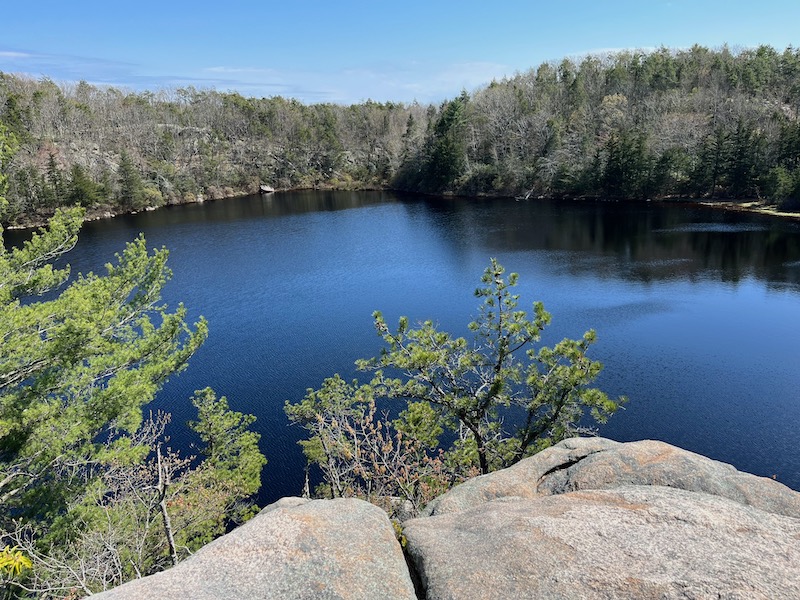
Some sections of these trails allow hunting, so you should wear orange during hunting season. Hunting season is from the 3rd Saturday in October through the last day in February, and from April 25 through the last day in May.
Ell Pond gets its name from its L shape. Camp Yawgoog should not be confused with Yawgoo Valley Ski Area, Rhode Island’s only ski area, which is in Exeter.
The EllPond/LongPond trail is part of the Narragansett Trail, which has yellow blazes in Rhode Island; the Narragansett Trail is 25-30 miles, and is partly in Connecticut, partly in Rhode Island. I parked on North Road, as Weber suggests. But it’s a rough, unpaved road, and the parking area is tiny, so it might be better to park on Canonchet Road, at the eastern tip of the above route.
If you start by walking south from North Road, you’ll notice an abundance of Mountain Laurel and Rhododendron. “In early summer,” Weber writes, “the profusion of blossoms in the first 200 yards creates a gardenlike atmosphere.”
Mountain Laurel (Kalmia latifolia) is a native plant. Wikipedia says it blooms in May and June. It’s an “evergreen shrub,” i.e., it keeps its leaves year-round. Wikipedia says it thrives on rocky slopes and acid soils (bogs make acid soil, and much of this area may have been bog).
Rhododendron (Rhododendron maximum) is also a native plant, also in the heath family (Ericaceae), and also an evergreen shrub. Wikipedia says it flowers in June and July.
If you look closely at the map, you’ll notice a short detour to Ell Pond (west), and a longer detour toward Long Pond (east). The EllPond detour brings you to a broad ledge with a view of Ell Pond (the view is obscured by trees). The LongPond detour brings you to a high cliff, and a good view of Long Pond; perhaps the cliff is what experts call a “granitic monadnock.”
When you’ve completed the detours, continue on the yellow-blazed trail as it descends through a cleft in the rock. “Solid walls of stone loom above you on both sides of the trail,” Weber writes. Then the trail takes a bridge over a stream (the stream carries water from Ell Pond to Long Pond). The stream is a low point on the trail.
From here, the trail climbs to what Weber calls The Cathedral. “Dense hemlocks form the ceiling, keeping the ‘room’ permanently dimmed, and huge stones represent the pews.” Some of the largest hemlocks have gone ad patres, so the “cathedral effect” is weaker. Surprisingly, the entire 5.7-mile route only climbs 260 feet, but there are steep sections, and you’ll be breathing heavily.
Weber says, “There is more up-and-down going beyond the cathedral, until you see a tumbledown stone wall.” This “stone wall” is, in my view, a stone row made by Native Americans. Since the trail runs parallel to the stone row (and parallel to the pond), it’s a good chance to observe Indian workmanship, and observe how a stone row differs from a stone wall made by whites.
As I was walking east, with the pond on my left and the stone row on my right, I noticed another stone row, perhaps 200 yards beyond the first stone row. Stone rows often form an enclosure, so I wasn’t surprised to see this second row. Nor was I surprised to see stone piles in the enclosure (i.e., between the stone rows). Below is one of these stone piles; notice how the “head stone” (in the bottom of the picture) makes the pile resemble a turtle. Such turtle effigies are quite common.
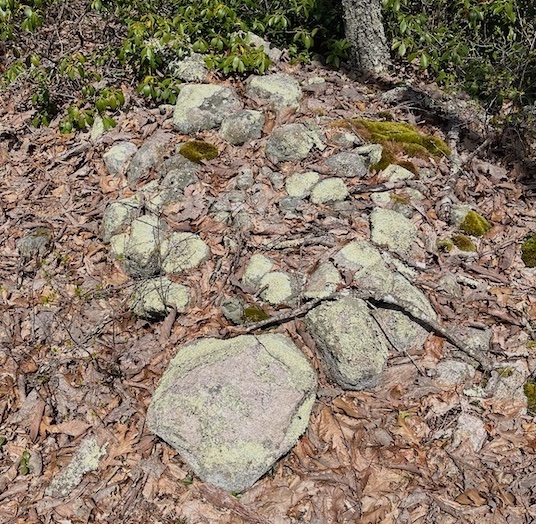
I marked the location of the “turtle” with a yellow pin. Southwest of the yellow pin are additional stone-structures. NEARA members may be able to get a detailed report on this area.
Further south, I put a red hiker icon on a cave formed by leaning boulders, and I put a blue hiker icon on a propped boulder. I reached these spots by bush-whacking from the Stubtown Road Trailhead, which is directly south of the blue hiker icon, and is marked on Google Maps. Bush-whacking in this area is very difficult, I don’t recommend it.
Let’s return to our map. The western half of the route follows North Road, then enters Camp Yawgoog. I wanted to see Yawgoog’s petroglyphs, which are on a trail called Symbol Rock. These petroglyphs seem genuine and ancient, almost certainly Native American.
Shortly after you turn off North Road, you meet a red-blazed trail. Right or left at this fork? Take the left fork for the petroglyphs. Follow the red trail for a few minutes. I put a red pin at the spot where you should turn north onto the Symbol Rock Trail, if you want to see the petroglyphs. (I had some difficulty finding Symbol Rock Trail, so I wandered around in Yawgoog. You can see the petroglyphs by a much shorter route than I took.)
Below is a picture of the small, round sign that says “Symbol Rock Trail”; the sign is on rising ground, and the area doesn’t look like a trail; it’s easy to miss.

Below is the same picture, with a circle around the sign:

If you walk north on the Symbol Rock Trail, you’ll come to this petroglyph first:

I marked the above petroglyph with a purple pin on the map. Here’s the same picture with the petroglyph marked:

Here’s the other side of the same stone:
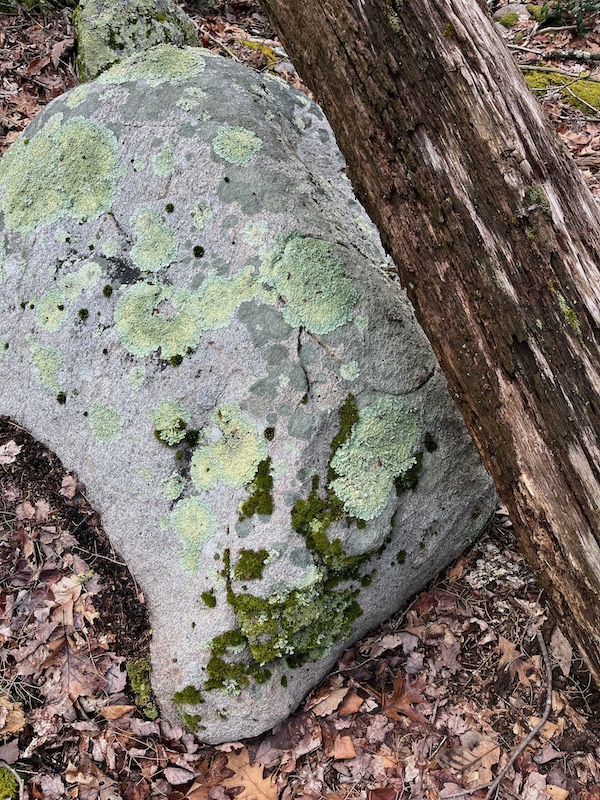
To see another petroglyph, continue north on the Symbol Rock Trail. I marked this second petroglyph with an orange pin (picture below).

Below is the same picture with the petroglyph outlined:

Where did I hear about the petroglyphs? Perhaps from a website called Strange New England. Below is the website’s picture of the second petroglyph:
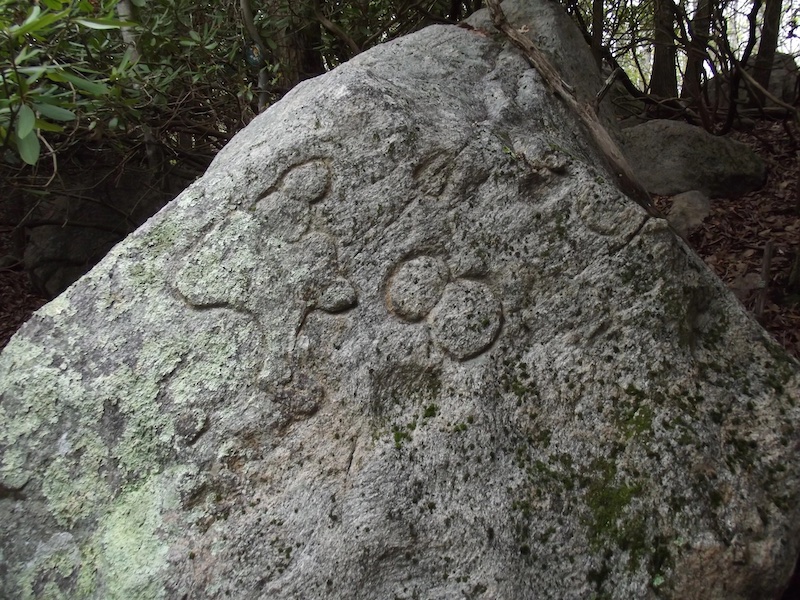
Camp Yawgoog is almost 100 years old. Are the petroglyphs mentioned on early maps/descriptions? If so, that would eliminate the possibility that they were carved recently.
Click here for a Yawgoog trail map. Yawgoog trails aren’t well marked, but the map is somewhat helpful. AllTrails doesn’t help much, perhaps because it thinks that a scout camp is “off limits.” The Symbol Rock Trail is in the upper left, in light-green. You may want to rotate the map to the left, so it’s aligned north-south. The Yawgoog map indicates that the first petroglyph is “Millennium Rock,” and the second, more northern petroglyph is “Symbol Rock.”
Below is a route that starts on Canonchet Road, the eastern tip of the previous route, then circles around Ashville Pond. The route below is 3.2 miles; it takes you to a parking lot on Stubtown Road, then it circles back to the starting point via paved roads (quiet roads).
The route above is not as spectacular as the EllPond/LongPond area. But if you like Indian stones, you’ll want to take this route.
From the StubtownRoad parking lot, you could walk west on Stubtown Road, and pick up the Narragansett Trail (yellow blazes), which would take you southeast to the Route 3/Main Street Trailhead, a distance of 2.8 miles; this section is sometimes called The Canonchet Trail. Or you could walk east on Stubtown Road, and pick up Table Rock Trail (orange blazes), which connects with the Canonchet Trail (yellow blazes); this option (the TableRock option) would make your road-walk shorter, and your trail-walk longer.
The route around Ashville Pond (see map above) has lots of erratic boulders, like Yawgoog and EllPond/LongPond. And it has lots of Mountain Laurel and Rhododendron. It doesn’t have the steep “granitic monadnocks” that make the EllPond/LongPond trail dramatic and difficult. The total climb for the Ashville Route is only 217 feet, so it’s quite a flat, easy trail. The EllPond/LongPond trail has water views, the Ashville trail doesn’t (except for a brief view of Ashville Pond). Ken Weber writes,
| after leaving the laurel thickets for a more open forest of hardwoods, you’ll see the numerous stone walls and rock piles. The walls seem to have been built randomly, running at many angles and in all directions, and the piles similarly defy explanation. |
This is a great description of Indian stones by someone who didn’t understand them, someone who is neither a believer nor a skeptic but simply a neutral observer. The stone rows seem to use the many erratic boulders; in other words, the stone rows start at one boulder, and extend to another boulder, or include a boulder in their midst. The stone mounds also use the erratic boulders, the mounds are often built on top of the boulders.
I’ve often wondered, How old are Indian stone structures? The picture below may give us a clue. Note how the stones use the roots. Since the roots probably aren’t more than 25 years old, the stones were placed within 25 years. If this reasoning is valid, natives are still making stone structures, so it should be possible to discuss the structures with them, or observe them at work. I’m not suggesting that all Indian stone structures were built recently; rather, I’m saying that there’s some evidence that some Indian stones were built recently.

I marked the location of the above mound with a blue pin. The above mound is in a large area of Indian stones (stone piles, stone rows).
I had heard that Native Americans had a special interest in cleft rocks, and often put smaller rocks into the cleft. But I never saw a good example of this. Below is such an example: a cleft rock, with a smaller rock wedged into the cleft. I marked its location with a green pin.
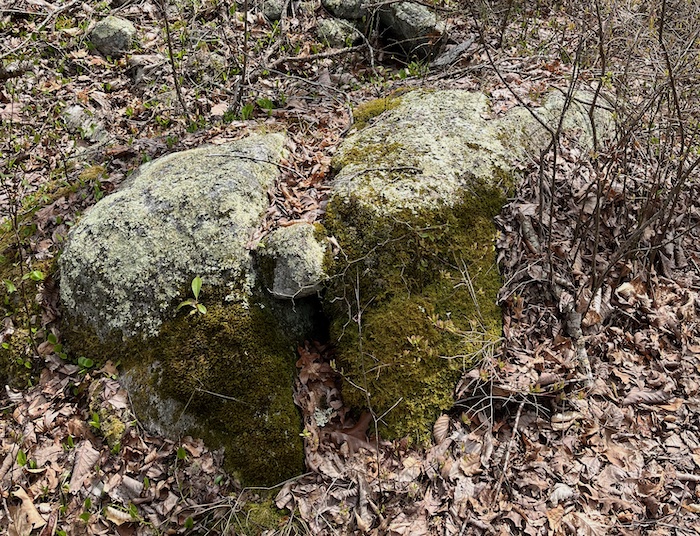
When I reached Stubtown Road, I began walking east, as Weber suggests. At the corner of Stubtown Road and Canonchet Road, “you’ll see the remains of a mill [Weber writes] across from a house that a plaque says was built in 1762. As you take Canonchet Road to the left, you’ll follow a canal that was built to carry water from Ashville Pond to the mill.” When you reach Ashville Pond, “the road is built on what was the pond’s dam, and on the opposite side of the road you can see the stonework that channeled a brook into the pond.” Is there a second stream flowing out of the pond, a few yards south of the “brook” flowing into the pond?
| Footnotes | |
| 1. | Ell Pond is described thus: “This kettle hole is surrounded by a swamp of red maple and Atlantic white cypress with steep granitic monadnocks. There is a rare mix of both hydrophytic and xeric plants [i.e., aquatic and desert plants].” back |